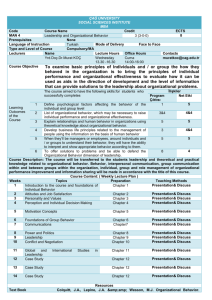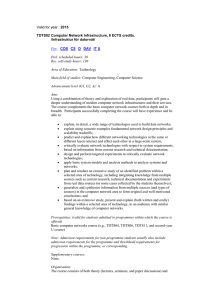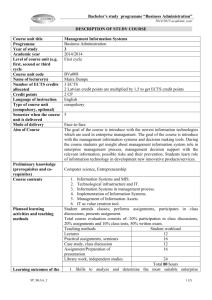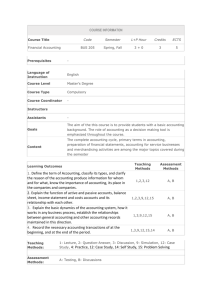PLA2 Marketing Processes - Fontys International Campus Venlo
advertisement
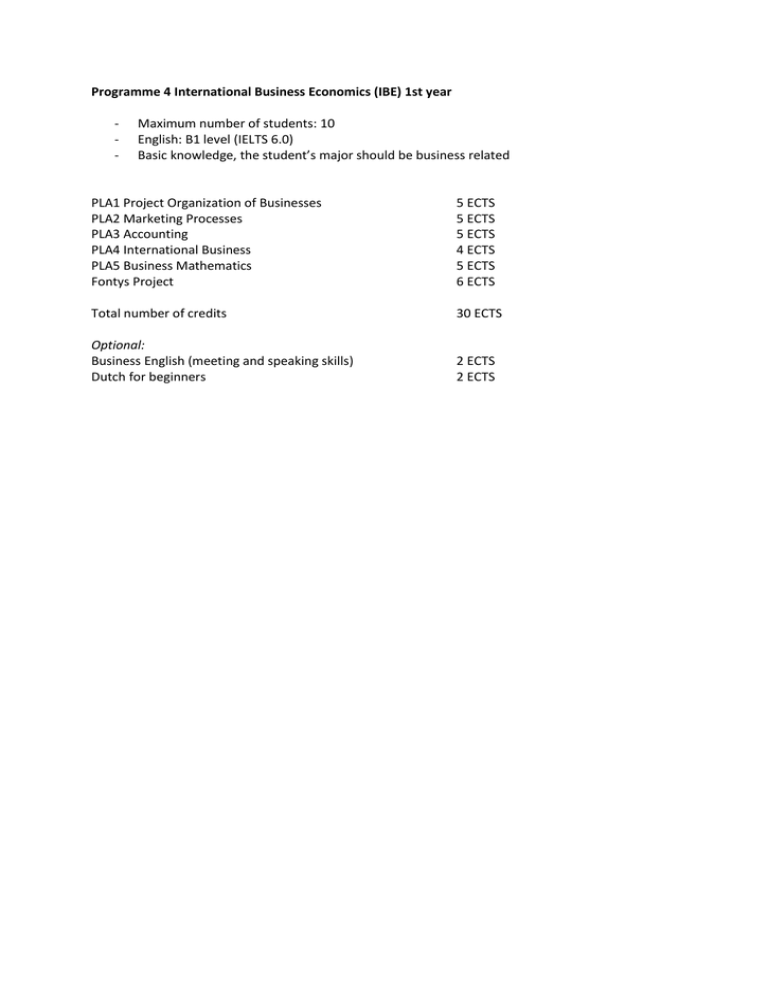
Programme 4 International Business Economics (IBE) 1st year - Maximum number of students: 10 English: B1 level (IELTS 6.0) Basic knowledge, the student’s major should be business related PLA1 Project Organization of Businesses PLA2 Marketing Processes PLA3 Accounting PLA4 International Business PLA5 Business Mathematics Fontys Project 5 ECTS 5 ECTS 5 ECTS 4 ECTS 5 ECTS 6 ECTS Total number of credits 30 ECTS Optional: Business English (meeting and speaking skills) Dutch for beginners 2 ECTS 2 ECTS PLA1 Project Organization of Businesses Brief description In this course the student executes a project in a group. The project consists of an internal and external analysis leading to recommendations to a company which the students choose themselves. First, information is sourced from desk research and expert interviews with managers of the chosen firm. Second, the students write an individual report that presents recommendations on how to change the internal organisation of the company to best fit the external environment. In this course the student deals with: organisation theory, project management, report writing and interviewing. Didactic methods Didactic methods used are the following. First, tutorials will provide students with theory on project management, organisation theory, interviewing, analyses tools used in this course and report writing. In addition, three hours per week give enough room to practice interviewing in class, use exercises to further familiarize students with the analyses tools, and to practice report writing on report examples. Second, in groups of five, students collect information about a company of their choice (project activities) through desk and field research. Third, three consultation hours per group will ensure a smooth group process and sufficient interim feedback on project activities from the lecturer’s side. Fourth, students will have to study course material individually. Method of testing and criteria The testing of this course consists of an assessment of the process and an assessment of the individual report (final examination). The group file represents the process assessment. The group file is handed in before handing in the report. If the group file is assessed with a NO GO (i.e. at a grade below 5.5), the students are not allowed to hand in the individual report. In case of an insufficient grade for the group file, the project group can readmit the group file within three days. If the group file is still insufficient after handing in the second time, the end result for this course will be 0. The final examination in this course is the individual report. The determined grade for the individual report is 100% of the end grade of PLA 1. The report can be maximum 15 pages. Handing in more than 15 pages core text will result in a 1.0 as the final grade. In the testing of this course both content and report writing skills are judged. PLA2 Marketing Processes Brief description This course treats the marketing process as a basic structure for market-focused acting. In this course the focus will be on the basis of the entire marketing process in particular the subsections of marketing analysis, segmenting and target group identification as well as marketing-mix. This course consists primarily of interactive lectures (theory) connected with topic-referred, practice-oriented exercises. Didactic methods The LA consists primarily of interactive lectures (theory) connected with topic-referred, practiceoriented exercises. Method of testing and criteria To round off the course, the student will participate in a 60 minutes examination (closed book written exam) during regular examination weeks. The students receive questions to the treated main topics (week 1-15). The individual knowledge based on certain competences is exemplary examined. PLA3 Accounting Brief description This course is set up as an introduction to Accounting and Finance. From time to time international managers will have to deal with the Finance Department of the organisation. An important part of the information, which is used for decision-making, is provided by this department. During this course, the student will learn about the day-to-day activities within this department. While carrying out these activities, the results of all management processes will come together. This way, the student will gain insight in a company’s administrative organisation. Didactic methods Students obtain knowledge and skills through tutorials and self-study. During the tutorials there will be brief outlines on specific subjects and the opportunity to ask questions. In every class students will have time to master skills by doing book exercises. For this course there is a “companion website” (http://wps.pearsoned.co.uk/ema_uk_he_black_introaccfin_1 ) where students can find and outline on the chapter contents, extra questions (multiple choice and true/false) and long questions/exercises (Excel). Upon request the outcome of these exercises/long questions can be discussed in class. Method of testing and criteria Examination Procedure Procedure exams A, B In L8 (lesson week 8) a written test A of 60 minutes will take place. The study material that is tested has been taught in lecture week 1 through 7. In the regular exam week a written test B of 60 minutes will take place. The study material that is tested has been taught in lecture week 9 through 15. The final grade is determined by the formula: 0.5 times grade exam A plus 0.5 times grade exam B, where both grades and final grades will be rounded to one decimal place. When a student has not participated in an exam the number 0.1 will be registered (for administrative reasons). There will be no minimum grade for exam A or exam B. To complete the course successfully, the average of exam A en B has to be 5.5 or higher. PLA4 International Business Brief description You will be introduced into the principles of international business and management. What does it mean to go across borders? What will be different from producing and selling domestically? How to adapt your business to the needs of the international market? You will become more aware of these and other aspects of doing business internationally. Also, the course will help you train your ability to critically analyse developments in a global industry and to evaluate foreign markets. Didactic methods A case study will be used to illustrate different topics in international business and management. A series of lectures will support students in understanding these topics. In addition, exercises will be offered to support the students while learning the topics. Method of testing and criteria Procedure exams A, B In L8 (lesson week 8) a written test A of 60 minutes will take place. The study material that is tested has been taught in lecture week 1 through 7. In the regular exam week a written test B of 60 minutes will take place. The study material that is tested has been taught in lecture week 9 through 15. The final grade is determined by the formula: 0.5 times grade exam A plus 0.5 times grade exam B, where both grades and final grades will be rounded to one decimal place. When a student has not participated in an exam the number 0.1 will be registered (for administrative reasons). There will be no minimum grade for exam A or exam B. To complete the course successfully, the average of exam A en B has to be 5.5 or higher. PLA5 Business Mathematics Brief description In this course, the student is trained in mathematical methods that are used to analyze and solve problems in economics, management and business. Some main subjects are financial calculations, optimization problems, and the analysis of Supply and Demand Curves, of Cost Functions and Profit Functions. The analysis can be carried out with various tools, including graphs. The problems can be solved “on paper” or by the use of a handheld electronic calculator. Didactic methods Lectures: these have an interactive style and serve to expose the main theory with telling examples. Self-study: students use the textbook and their own lecture notes. The lecturer will provide documents to guide the self-study. (Note that also school has rooms for study, alone or together with others). Assignments: students may receive small assignments for tackling a problem. Exam training: students receive test papers, with detailed solutions, from the recent past of this course. Web based activities: students can use the website relating to the textbook, receive mails from the lecturer, and references by the lecturer to useful websites. The lecturer is generally available by email. Examination Procedure Procedure exams A, B In L8 (lesson week 8) a written test A of 60 minutes will take place. The study material that is tested has been taught in lecture week 1 through 7. In the regular exam week a written test B of 60 minutes will take place. The study material that is tested has been taught in lecture week 9 through 15. The final grade is determined by the formula: 0.5 times grade exam A plus 0.5 times grade exam B, where both grades and final grades will be rounded to one decimal place. When a student has not participated in an exam the number 0.1 will be registered (for administrative reasons). There will be no minimum grade for exam A or exam B. To complete this course successfully, the average of exam A en B has to be 5.5 or higher. Fontys Project Project is being developed, more information soon


